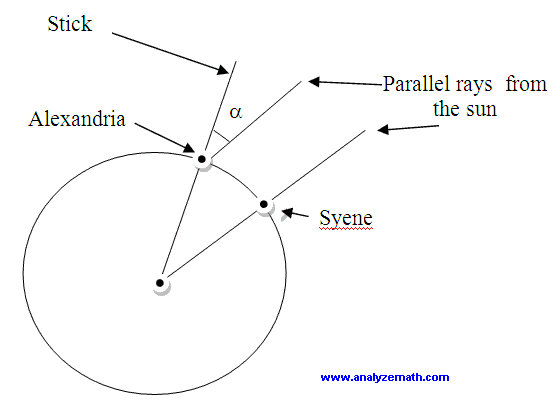I found that historical facts about mathematics and real life mathematical problems motivate students. I use both to highlight the power of mathematics and its applications. Below is a real life problem related to trigonometry about measuring the circumference of the earth [1].
Problem 8: More than two thousand years ago Eratosthenes of Cyrene (276 BC-194 BC), a Greek mathematician, used the rays from the sun and the shadow of a stick to measure angle ? = 72 degrees. Assume that the ray from the sun falls vertical at Syene and the stick used at Alexandria is also vertical. Assume also that the earth is circular and find the circumference of the earth.

Students are more interested in real life problems because they make sense and also give reasons to study mathematics.
3.5 Metacognition and Problem SolvingThe term metacognition refers to a learners knowledge about his or her process of cognition and the ability to control and monitor those processes as a function of the feedback the learner receives via outcomes of learning [14]. Learners must control and reflect on their cognitive processes in order to solve challenging problems. It is thought that the best way to help students become aware about their own thinking is to create opportunities where they have to explain their thinking explicitly. As an example let us look at the following problem.
Problem 9: Ahmed walked at a constant speed of 6 km/hour along a straight line from A to B, then walked back along the same line from B to A at a constant speed of 4 km/hour. What is the average speed over the entire trip? (Definition: Average speed = total distance / total time)
When the above problem was given to students in level (2) advanced mathematics, all students answered the question as follows:
When asked to explain their answer, they said that any average is found by adding all data values and divide the sum obtained by the number of data values. They simply ignored the definition given to them. I next guided them to work in groups, look back at the problem and use the definition to answer the question. They had to justify the steps of their calculations and their thinking within their group. When the correct answer based on the definition was obtained, I asked students to discuss within their groups what happened and why all students answered the question without taking into account the definition. I explicitly ask them to think about the way they solved the problem and why.
Metacognitive skills help students to analyze both the question and the solution developed. They also help students to look back at the problem and restart if necessary. In designing activities that may help students be aware of their metacognitive skills, I have taken into account the following: 1. Metacognitive skills have to be taught explicitly.[15-18] 2. Only genuine mathematical problems, that students have not solved before, help them develop metacognitive skills. 3. Students need to explain to other students and the teacher their way of thinking. 4. I sometimes use examples to explain my own thinking in solving problems.